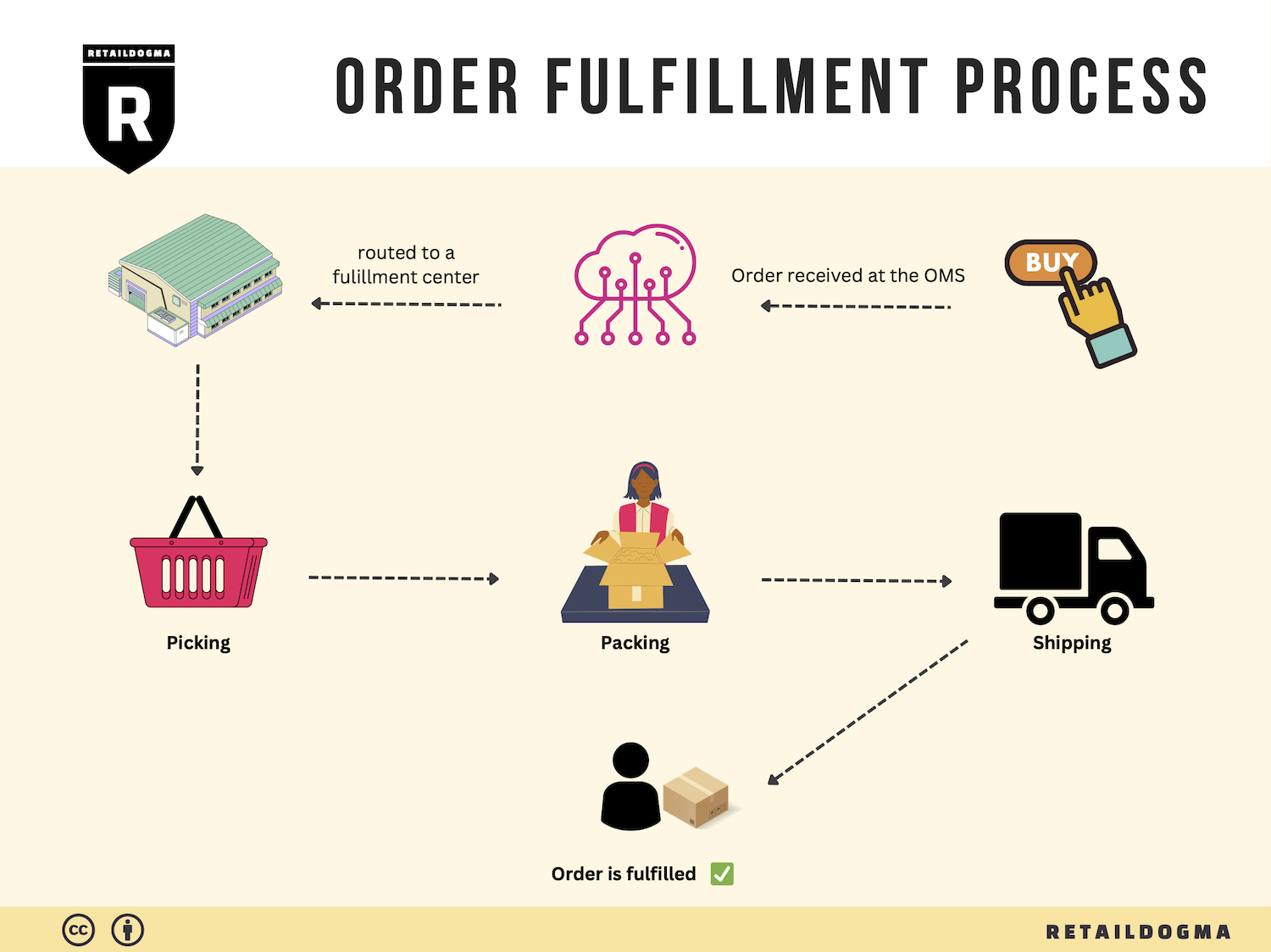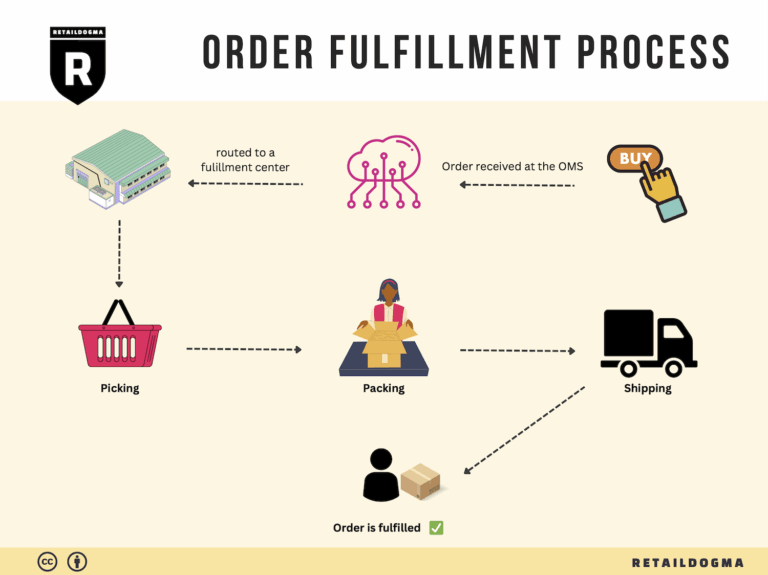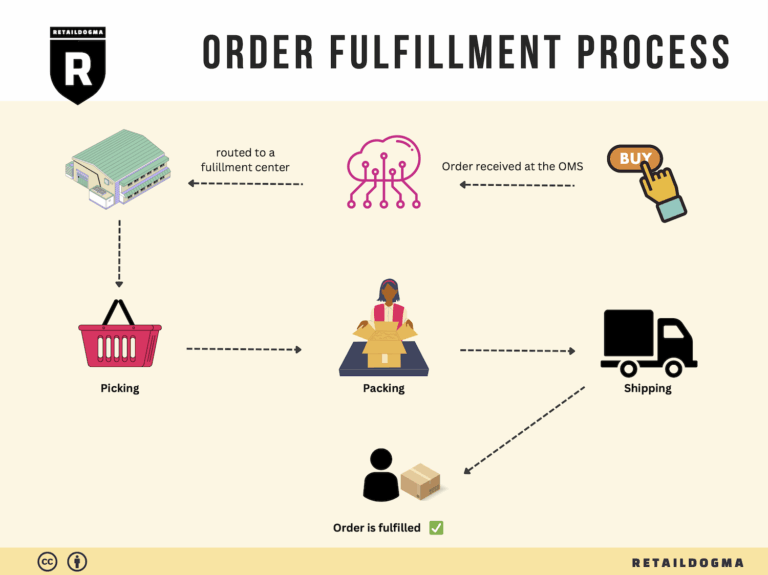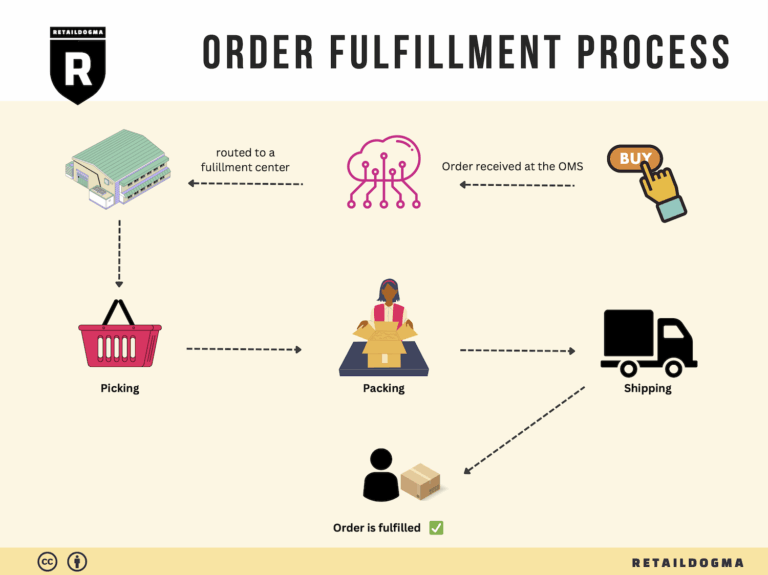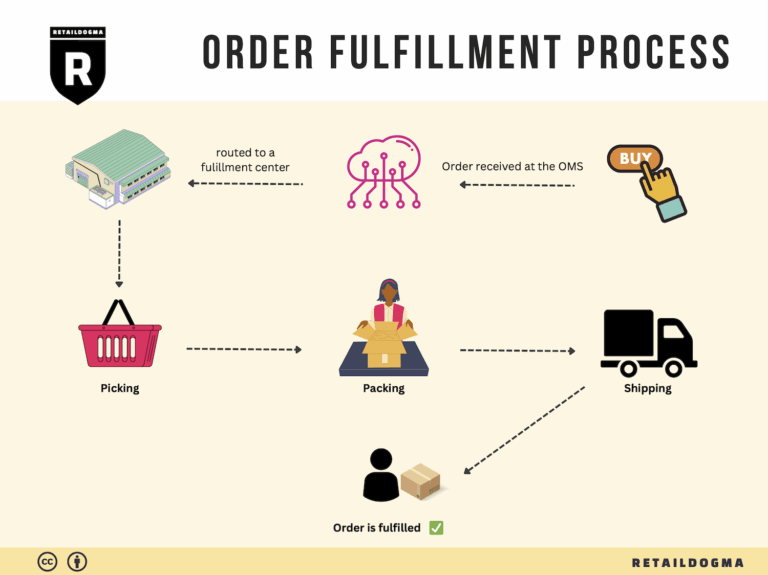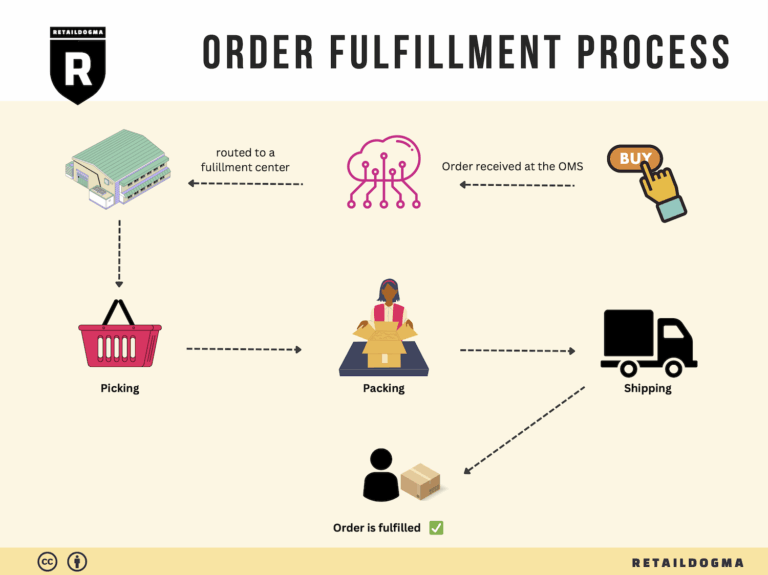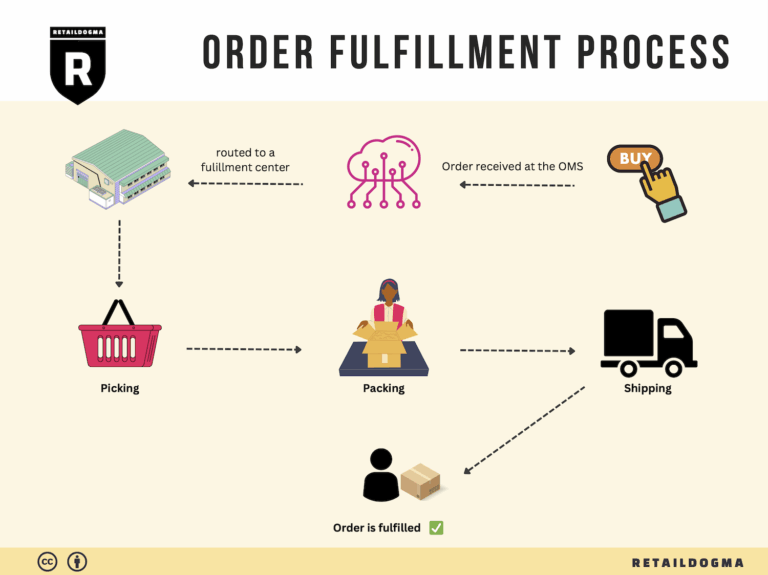What Is A Fulfillment Center? A Complete Guide (2025)
What is E-commerce Fulfillment? An Introduction for Growing Businesses
Understanding the Challenges of E-commerce Fulfillment
For many growing online businesses, the excitement of increasing sales can quickly turn into overwhelming stress when it comes to packing and shipping orders. As orders multiply, the complexities of managing inventory, ensuring timely deliveries, and maintaining customer satisfaction can feel daunting. This is where e-commerce fulfillment comes into play.
At its core, fulfillment is simply the process of getting a product into the hands of the customer. It encompasses everything from receiving inventory and storing it, to picking, packing, and shipping orders efficiently. For businesses looking to scale, mastering this process is essential to sustaining growth and ensuring customer loyalty.
What This Guide Covers
In this guide, we will explore various fulfillment models that can support your business as it grows. You’ll learn about Third-Party Logistics (3PL) and Fulfillment by Amazon (FBA), as well as other solutions tailored to meet the unique needs of e-commerce businesses. Each model offers distinct advantages and challenges, and understanding these will help you make an informed choice.
Additionally, we will delve into the core services involved in fulfillment, including inventory management, order processing, and returns handling. Each of these elements plays a crucial role in delivering a seamless experience to your customers.
Choosing the right fulfillment partner is another critical aspect we will cover. The right partner can enhance your operational efficiency, reduce costs, and ultimately improve customer satisfaction. We will provide practical tips on what to look for in a fulfillment partner, including technology integration, service levels, and scalability.
Lastly, we will discuss pricing structures associated with different fulfillment options. Understanding these costs is vital for budgeting and financial planning, ensuring that your fulfillment strategy aligns with your overall business goals.
Empowering Smart Decisions in Logistics
The goal of this guide is to empower you, the business owner or operations manager, to make smart, strategic decisions about your logistics. By understanding the intricacies of e-commerce fulfillment and leveraging the right solutions, you can focus on what you do best—growing your business. Together, we’ll navigate the landscape of fulfillment and help you build a robust logistics strategy that supports your growth ambitions.
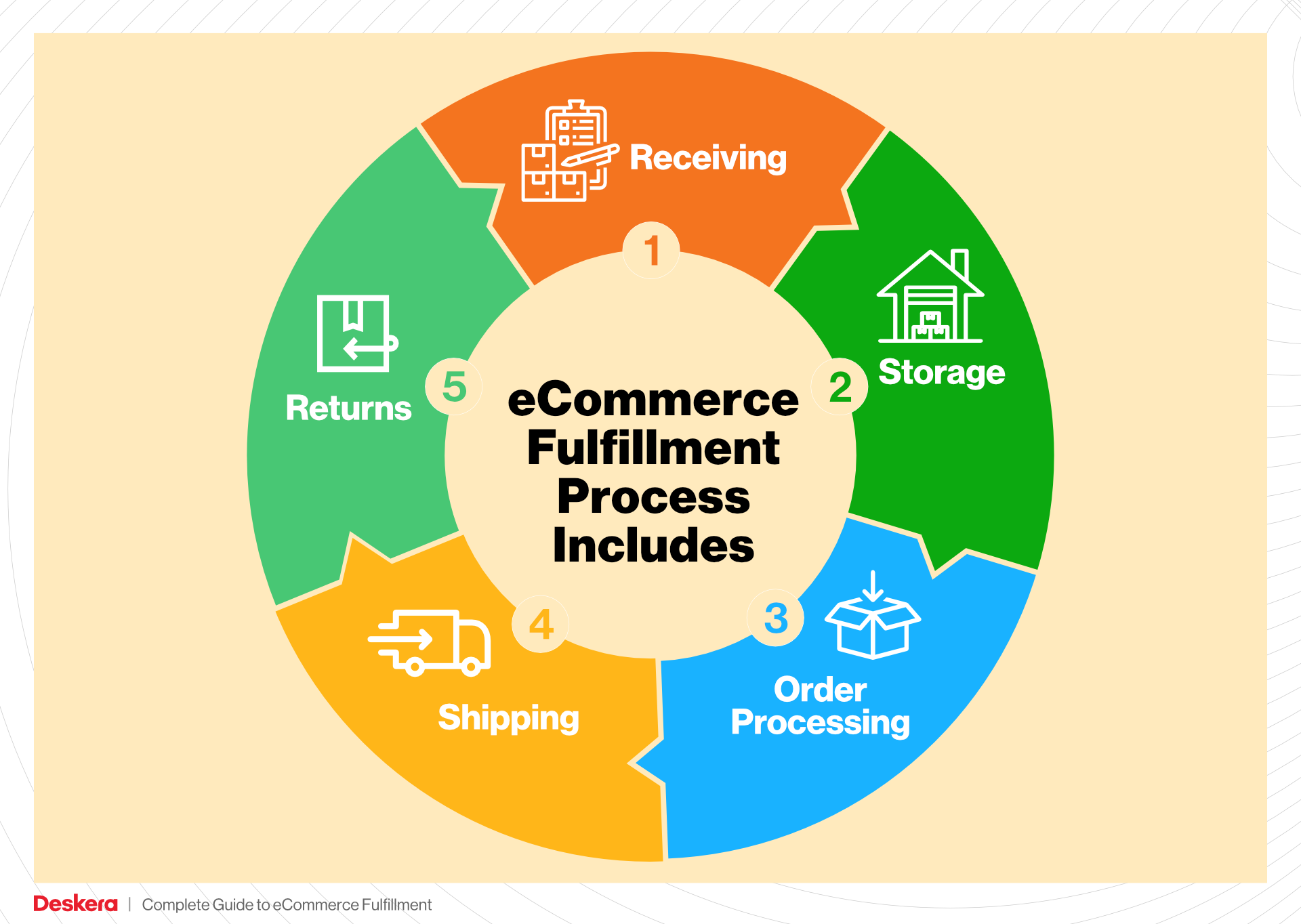
What You’ll Learn In This Guide
- What is E-commerce Fulfillment? An Introduction for Growing Businesses
- The Order Fulfillment Process: From ‘Buy’ Button to Customer’s Door
- Comparing Fulfillment Models: In-House vs. 3PL vs. Dropshipping
- A Deep Dive into Amazon FBA: Pros, Cons, and Who It’s For
- Core Services Offered by Fulfillment Centers
- How to Choose a Fulfillment Partner: A 6-Point Checklist
- Understanding Fulfillment Pricing: A Breakdown of Common Fees
- Frequently Asked Questions (FAQs) about Fulfillment
- Conclusion: Is Outsourcing Fulfillment the Right Move for Your Business?
- Important Disclaimer
The Order Fulfillment Process: From ‘Buy’ Button to Customer’s Door
1. Receiving Inventory
The order fulfillment process begins with receiving inventory, where products from suppliers are delivered to the warehouse. This step is critical as it sets the foundation for effective inventory management and ensures that the products are ready for sale.
Upon arrival, the shipment is checked against purchase orders (POs) to confirm that the correct items and quantities have been received. This verification process is essential to avoid discrepancies that could lead to stockouts or overstock situations. A key term associated with this step is SKU (Stock Keeping Unit), which uniquely identifies each product variant. Properly managing SKUs helps streamline inventory control and enhances tracking capabilities.
Accurate receiving also involves inspecting goods for damage and recording their condition. Any issues must be documented and reported to the supplier promptly to facilitate returns or replacements. The effectiveness of this step impacts the overall fulfillment process, as inaccuracies can ripple through to later stages, affecting customer satisfaction and operational efficiency.
2. Warehouse Storage
Once the inventory is received and verified, it is stored in the warehouse. Efficient storage solutions are essential for maximizing space and ensuring quick access to products. This step involves organizing items in a manner that supports fast retrieval, often utilizing a warehouse management system (WMS) to track inventory levels and locations.
Proper warehouse layout and storage strategies are crucial. Products should be stored according to their demand, with high-velocity items placed closer to picking areas to reduce retrieval time. This organization not only optimizes operational efficiency but also minimizes the labor costs associated with order fulfillment.
Effective warehouse storage also includes implementing inventory accuracy practices, such as cycle counting and regular audits. Maintaining accurate inventory levels helps prevent stockouts and overstock situations, ensuring that businesses can meet customer demand without excessive holding costs.
3. Order Picking
With inventory stored and organized, the next step is order picking, where items are selected from the warehouse to fulfill customer orders. This step is vital as it directly impacts order accuracy and speed, which are crucial for customer satisfaction.
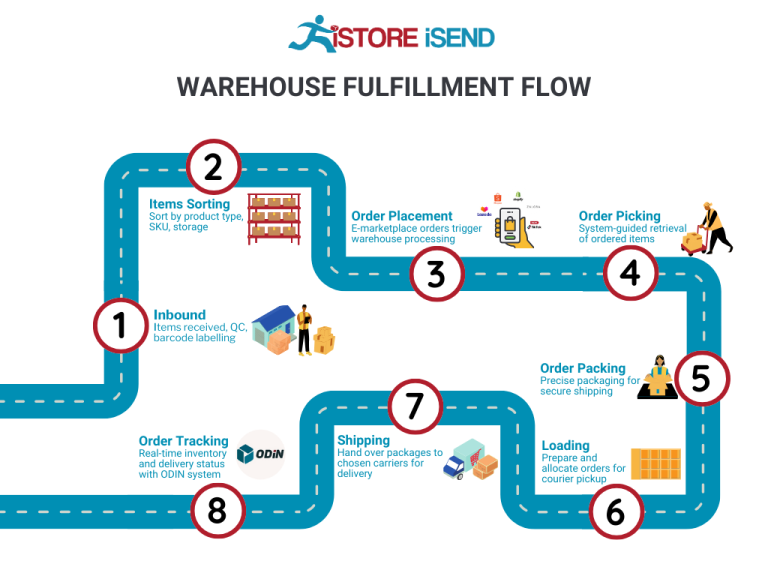
Orders are typically processed using pick lists, which outline the items and quantities needed for each order. Efficient picking methods—such as batch picking, wave picking, or zone picking—can significantly enhance productivity. Batch picking allows workers to fulfill multiple orders simultaneously, while zone picking divides the warehouse into sections, assigning pickers to specific areas.
The accuracy of this step is paramount. Errors during picking can lead to incorrect shipments, resulting in returns and decreased customer trust. Implementing technology, such as barcode scanners or RFID systems, can enhance picking accuracy and streamline the process, ensuring that the right products are selected for each order.
4. Order Packing
Once items are picked, they move on to the packing stage. Proper packing is essential to protect products during transit and ensure they arrive at the customer’s doorstep in pristine condition. This step involves selecting appropriate packaging materials, labeling, and preparing the order for shipment.
Key considerations during packing include using the right box size to minimize shipping costs and prevent damage. Additionally, incorporating packing slips that detail the contents of the package can enhance transparency and customer experience.
Customization options, such as gift wrapping or including personalized notes, can also be offered at this stage, adding value to the customer experience and potentially increasing customer loyalty. Proper packing not only protects products but also reflects the brand’s commitment to quality and service.
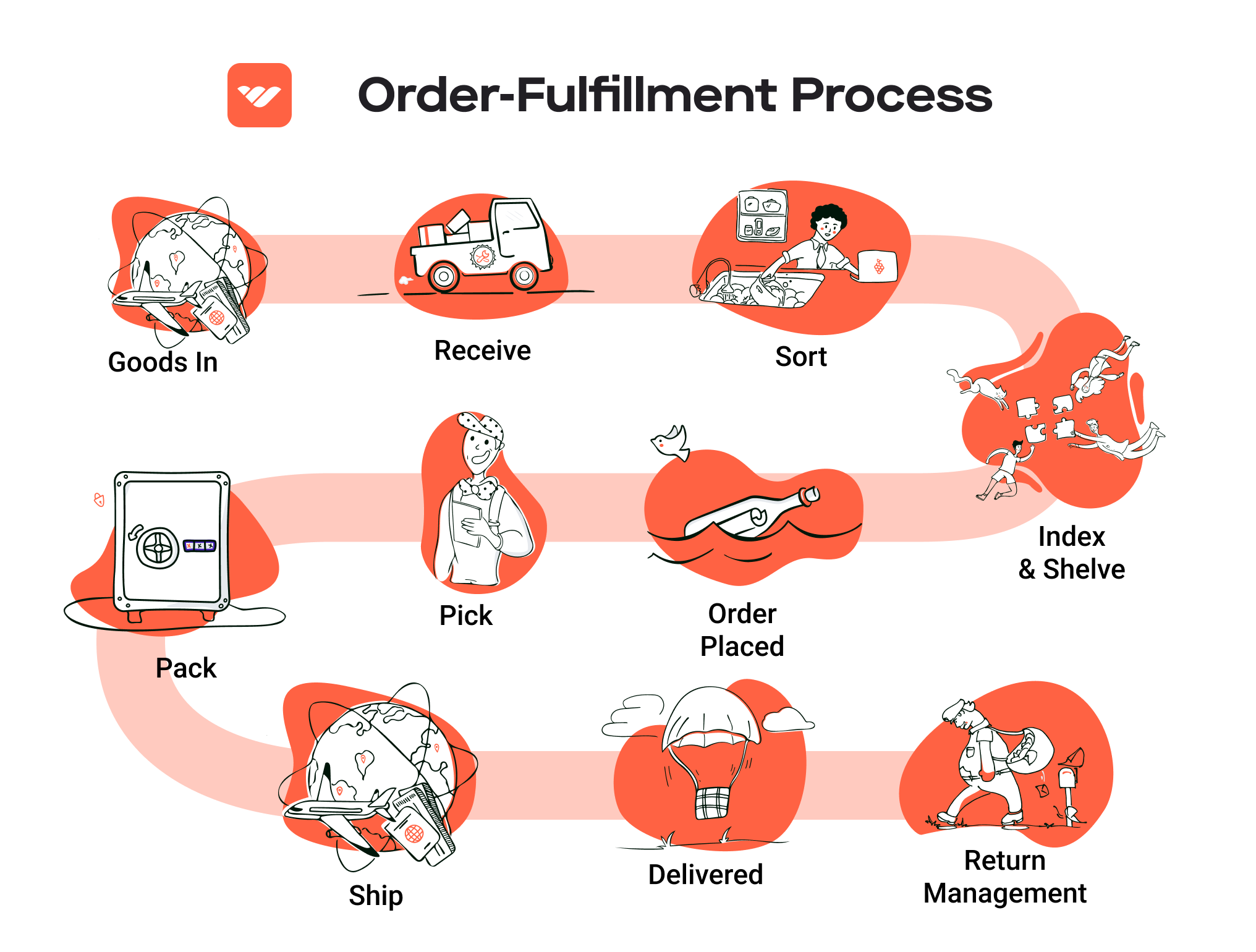
5. Shipping & Delivery
The final step in the order fulfillment process is shipping and delivery, where packed orders are dispatched to customers. This stage is critical, as it directly influences the customer’s perception of the brand and their overall experience.
Orders are typically shipped using various carriers, and businesses must choose the most cost-effective and reliable options. Timeliness is a key factor; many companies, like XB Fulfillment, offer same-day shipping for orders received by a certain time, enhancing customer satisfaction and trust.
Tracking shipments is an essential aspect of this process, allowing customers to monitor their orders in real-time. This transparency not only improves the customer experience but also reduces inquiries related to order status, freeing up customer service resources.
In conclusion, understanding and optimizing each step of the order fulfillment process—from receiving inventory to shipping and delivery—can significantly enhance operational efficiency, reduce costs, and improve customer satisfaction. By focusing on these key areas, e-commerce businesses can scale effectively and thrive in a competitive market.
Comparing Fulfillment Models: In-House vs. 3PL vs. Dropshipping
Comparison of Fulfillment Models
| Model | Who Handles Inventory | Best For (Business Stage) | Key Advantage | Key Disadvantage |
|---|---|---|---|---|
| In-House Fulfillment | Business itself | Established businesses | Full control over inventory and processes | High fixed costs and operational complexity |
| Third-Party Logistics (3PL) | Third-party provider | Growing businesses and startups | Scalable solutions and reduced overhead | Potential loss of control over fulfillment |
| Dropshipping | Supplier | Startups and low-capital businesses | Low initial investment and no inventory risk | Lower profit margins and reliance on suppliers |
In-House Fulfillment
In-house fulfillment refers to managing all aspects of the storage, packing, and shipping of products within your own business operations. This model is often favored by established businesses that have the resources to maintain a warehouse, hire staff, and invest in logistics technology. The key advantage of in-house fulfillment is the complete control it offers over inventory management and order processing. Businesses can implement tailored strategies, adjust processes quickly, and maintain direct oversight of the customer experience. However, this model comes with significant disadvantages, including high fixed costs associated with maintaining a warehouse and staffing, as well as the complexity of managing logistics. Moreover, during peak seasons, businesses may struggle to scale operations effectively, leading to potential delays and customer dissatisfaction.
Third-Party Logistics (3PL)
Third-party logistics (3PL) providers offer outsourced logistics services that include warehousing, order fulfillment, and shipping. This model is particularly beneficial for growing businesses and startups that are looking to scale without the heavy burden of managing logistics internally. By partnering with a 3PL like XB Fulfillment, businesses can leverage advanced technology, skilled labor, and established logistics networks to enhance their fulfillment capabilities. The primary advantage of using a 3PL is scalability; businesses can adjust their fulfillment needs based on demand without incurring the fixed costs of in-house operations. Furthermore, 3PLs often provide additional services such as inventory management and customer support, which can significantly improve operational efficiency. However, the main downside is the potential loss of control over the fulfillment process, which can impact order accuracy and customer satisfaction if not managed properly. Businesses must choose a reputable 3PL partner to mitigate these risks and ensure a seamless customer experience.
Dropshipping
Dropshipping is a fulfillment model where the retailer does not hold inventory but instead transfers customer orders directly to a supplier, who then ships the products directly to the customer. This model is ideal for startups and low-capital businesses as it requires minimal upfront investment and eliminates the need for warehousing and inventory management. The key advantage of dropshipping is the reduced financial risk since businesses only pay for products after they have made a sale. Additionally, this model allows entrepreneurs to offer a wide range of products without the complexities of inventory management. However, dropshipping also presents significant challenges, including lower profit margins due to reliance on suppliers and potential delays in shipping, which can harm customer satisfaction. Businesses must also contend with less control over product quality and fulfillment timelines, making it essential to choose reliable suppliers and establish clear communication channels to ensure a smooth operation.
Conclusion
Each fulfillment model has its own unique advantages and disadvantages, making it essential for e-commerce businesses to carefully consider their specific needs, resources, and growth objectives. In-house fulfillment may provide control but at a higher cost, while 3PL offers scalability and efficiency at the expense of some control. Dropshipping presents an opportunity for low-capital entry but comes with challenges related to profit margins and supplier reliability. Ultimately, the choice of fulfillment model should align with the business’s long-term strategy and operational capabilities, ensuring that it can effectively meet customer expectations while supporting growth.
A Deep Dive into Amazon FBA: Pros, Cons, and Who It’s For
Understanding Fulfillment by Amazon (FBA)
Fulfillment by Amazon (FBA) is a service offered by Amazon that allows sellers to store their products in Amazon’s fulfillment centers. Amazon then takes care of storage, packaging, shipping, and customer service for these products. This service is designed to simplify the logistics process for sellers, allowing them to focus more on growing their business while leveraging Amazon’s vast logistics network.
How FBA Works
-
Product Listing: Sellers create product listings on Amazon. They can either sell their own products or source them from third-party suppliers.
-
Inventory Shipment: Sellers ship their products to Amazon’s fulfillment centers. Amazon provides guidelines on how to package and label items.
-
Storage: Products are stored in Amazon’s warehouses until they are sold. Sellers can monitor their inventory levels via the Amazon Seller Central dashboard.
-
Order Processing: When a customer places an order, Amazon picks, packs, and ships the product on behalf of the seller.
-
Customer Service: Amazon handles all customer inquiries and returns related to FBA orders. This includes managing returns and refunds.
-
Payment: After a sale, sellers receive payment through Amazon, minus the fees associated with FBA.
Pros of Using FBA
-
Prime Eligibility: Products fulfilled by Amazon are eligible for Amazon Prime, which can significantly increase sales. Prime members often prefer to buy items that qualify for free two-day shipping, giving sellers access to a large base of loyal customers.
-
Customer Trust: Amazon has built a reputation for reliability and efficiency. Sellers can benefit from this trust, as customers are more likely to purchase items fulfilled by Amazon due to the perceived security and assurance of quality service.
-
Multi-Channel Fulfillment: FBA allows sellers to fulfill orders from other sales channels (like eBay, Shopify, etc.) using Amazon’s logistics. This means sellers can manage their inventory and shipping through a single platform while reaching customers across multiple marketplaces.
-
Scalability: FBA allows sellers to scale their operations without needing to invest in warehousing or additional staff. As demand increases, sellers can send more inventory to Amazon without worrying about logistics.
-
Time-Saving: By outsourcing fulfillment to Amazon, sellers can focus on other aspects of their business, such as marketing, product development, and customer engagement.
-
Detailed Analytics: Sellers gain access to Amazon’s comprehensive reporting tools, which can provide insights into sales trends, customer preferences, and inventory performance, enabling data-driven decisions.
Cons of Using FBA
-
High Fees: FBA comes with various fees, including storage fees, fulfillment fees, and additional costs for long-term storage. These fees can eat into profit margins, especially for low-cost items.
-
Strict Inventory Rules: Amazon has stringent policies regarding inventory management. Sellers must adhere to specific guidelines, such as labeling and packaging requirements, which can be time-consuming and complex.
-
Commingling Risks: When sellers use FBA, their inventory may be commingled with inventory from other sellers. This can lead to issues if a customer receives the wrong item or if there are quality control problems with products from other sellers.
-
Loss of Control: By outsourcing fulfillment to Amazon, sellers relinquish some control over their shipping and customer service processes. Any issues that arise are managed by Amazon, which can lead to frustrations if sellers feel their brand is not represented accurately.
-
Inventory Limitations: During peak seasons or based on seller performance, Amazon may impose limitations on the amount of inventory a seller can send to fulfillment centers. This can hinder growth opportunities during critical sales periods.
-
Long-Term Storage Fees: If inventory remains unsold for an extended period, Amazon charges long-term storage fees, which can lead to increased costs for sellers unable to move their products quickly.
Who is FBA Best For?
Fulfillment by Amazon is an excellent option for various types of sellers, particularly:
-
Small to Medium-Sized Businesses: Those looking to scale operations without the overhead of managing their own logistics can benefit significantly from FBA. It allows them to reach a broader audience and leverage Amazon’s infrastructure.
-
E-commerce Startups: New sellers can jumpstart their businesses without needing to invest heavily in warehousing and fulfillment.
-
Brands Seeking Prime Access: Brands that want to tap into the Prime customer base should consider FBA, as it can lead to higher visibility and sales.
-
Sellers with High Sales Volume: Businesses that have a steady stream of sales can leverage FBA’s efficiency to manage their orders and scale more quickly.
-
Multi-Channel Sellers: Those selling on multiple platforms can streamline their operations by using FBA to fulfill orders from various sales channels, simplifying logistics and inventory management.
In conclusion, while FBA offers numerous advantages for e-commerce sellers, it is essential to weigh these against the potential downsides. By understanding the intricacies of FBA, sellers can make informed decisions about whether this fulfillment method aligns with their business objectives and operational capabilities.
Core Services Offered by Fulfillment Centers
Inventory Management & Warehousing
Inventory management and warehousing form the backbone of a successful fulfillment operation. Fulfillment centers offer sophisticated inventory management systems that allow e-commerce businesses to track their stock levels in real time. This includes receiving goods, storing them efficiently, and monitoring inventory turnover rates.
Benefits:
1. Real-Time Visibility: Businesses gain access to dashboards that provide real-time data on inventory levels, helping to prevent stockouts and overstock situations.
2. Cost Efficiency: By optimizing warehouse space and utilizing advanced forecasting tools, fulfillment centers can help reduce storage costs and improve cash flow.
3. Scalability: As e-commerce businesses grow, fulfillment centers can easily adjust their inventory management practices to accommodate increased product lines and sales volumes, ensuring that companies can scale without logistical headaches.
Pick and Pack Services
Pick and pack services refer to the process of selecting items from warehouse shelves (picking) and preparing them for shipment (packing). This is a critical step in the order fulfillment process, as it directly impacts order accuracy and delivery speed.
Benefits:
1. Same-Day Shipping: Many fulfillment centers, like XB Fulfillment, offer same-day shipping for orders placed before a specific cutoff time. This feature enhances customer satisfaction by ensuring timely delivery.
2. Accuracy and Efficiency: Advanced technology and trained staff ensure high accuracy in picking and packing, minimizing errors that can lead to returns and customer dissatisfaction. XB Fulfillment boasts a near-perfect order accuracy rate, which is crucial for maintaining customer trust.
3. Customization: Businesses can offer personalized packaging options, such as gift wrapping or including handwritten notes, enhancing the customer experience and differentiating their brand in a competitive marketplace.
Kitting and Assembly
Kitting and assembly involve bundling multiple products together into a single package or assembling components into a finished product. This service is particularly beneficial for businesses that sell products that are often purchased together or require assembly before shipping.
Benefits:
1. Increased Average Order Value: By offering kits or bundles, e-commerce businesses can encourage customers to purchase more items at once, thus increasing the average order value.
2. Streamlined Operations: Outsourcing kitting and assembly to a fulfillment center allows businesses to focus on core activities, such as marketing and sales, while experts handle the logistics of product assembly.
3. Quality Control: Fulfillment centers often have quality control measures in place to ensure that assembled products meet specific standards before they are shipped, reducing the likelihood of returns due to defects or assembly errors.
Returns Management (Reverse Logistics)
Returns management, or reverse logistics, encompasses the processes involved in handling returned products. This service is essential for e-commerce businesses, as managing returns efficiently can significantly impact customer satisfaction and profitability.
Benefits:
1. Enhanced Customer Satisfaction: A streamlined returns process makes it easy for customers to return products, which can improve their overall shopping experience and increase the likelihood of repeat purchases.
2. Quick Restocking: Fulfillment centers often have systems in place to inspect, refurbish, and restock returned items quickly, minimizing the impact on inventory levels and cash flow.
3. Data Insights: Analyzing return data helps businesses identify trends, such as frequent reasons for returns, allowing them to make informed decisions about product quality and customer expectations.
In conclusion, leveraging the core services offered by fulfillment centers can provide e-commerce businesses with a competitive edge. From effective inventory management to streamlined returns processes, these services not only enhance operational efficiency but also improve customer satisfaction, ultimately leading to sustained growth and profitability. By choosing the right fulfillment partner, businesses can focus on scaling their operations while leaving the complexities of logistics to the experts.
How to Choose a Fulfillment Partner: A 6-Point Checklist
Location & Warehouse Network
Importance:
The geographical location of your fulfillment partner and their warehouse network play a critical role in your shipping efficiency and costs. A strategically located warehouse can significantly reduce shipping times and costs, impacting customer satisfaction and your bottom line.
Questions to Ask:
– Where are your warehouses located, and how do they align with our target market?
– What is your average shipping time to key regions?
– Do you have a network of warehouses that can scale with our growth?
– How do you manage inventory across multiple locations?
Technology & Integrations
Importance:
In the age of e-commerce, technology is a game changer. A robust technology platform can streamline operations, enhance order tracking, and provide real-time visibility into your inventory. Integration with your existing systems (e.g., ERP, CRM) is crucial for seamless operations.
Questions to Ask:
– What warehouse management system (WMS) do you use, and how does it enhance order fulfillment?
– Can your technology integrate with our current e-commerce platform?
– How do you ensure data accuracy and security within your systems?
– Do you provide real-time tracking for orders, and how accessible is that information?
Specializations (e.g., cold storage, oversized items)
Importance:
Not all fulfillment centers are equipped to handle specialized products. If your business involves unique storage needs, such as cold storage for perishables or oversized items, it’s essential to partner with a fulfillment provider that has the necessary capabilities.
Questions to Ask:
– What types of specializations do you offer (e.g., cold storage, hazardous materials)?
– Can you handle custom packaging or kitting?
– How do you ensure compliance with regulations regarding specialized products?
– What experience do you have with products similar to ours?
Scalability & Capacity
Importance:
As your business grows, your fulfillment partner must be able to scale operations to meet increased demand without compromising service quality. Understanding their capacity limits and growth capabilities is essential for long-term partnership success.
Questions to Ask:
– How do you handle peak seasons or unexpected spikes in demand?
– What is your current capacity, and how do you plan to expand it in the future?
– Can you provide case studies or examples of how you have scaled operations for other clients?
– What contingency plans do you have in place for capacity challenges?
Pricing and Contracts
Importance:
Understanding the pricing structure and contract terms is vital to ensure that the partnership aligns with your financial goals. Hidden fees can significantly impact your profitability, so clarity in pricing is essential.
Questions to Ask:
– What is your pricing model (e.g., per order, per item, monthly fees)?
– Are there any additional fees we should be aware of (e.g., storage, handling, returns)?
– What are the contract terms, and are there penalties for early termination?
– Can you provide a detailed breakdown of costs associated with our specific needs?
Customer Support & Reviews
Importance:
A responsive and knowledgeable customer support team can make a significant difference in your fulfillment experience. Additionally, checking reviews and testimonials can provide insights into the provider’s reliability and service quality.
Questions to Ask:
– What type of customer support do you offer (e.g., dedicated account manager, 24/7 support)?
– How do you handle customer inquiries and issues related to fulfillment?
– Can you share references or testimonials from current or past clients?
– What metrics do you use to measure customer satisfaction, and how do you improve based on that feedback?
Conclusion
Choosing the right fulfillment partner is a critical decision that can impact your e-commerce business’s efficiency, customer satisfaction, and overall profitability. By systematically evaluating potential partners using this checklist, you can make an informed choice that aligns with your operational needs and business goals. Always remember to conduct thorough research and consider engaging with current clients of the fulfillment provider to gain deeper insights into their performance and reliability.
Understanding Fulfillment Pricing: A Breakdown of Common Fees
Initial Setup Fees
Initial setup fees are typically charged when you first onboard with a third-party logistics (3PL) provider. These fees can cover the costs associated with integrating your systems with the 3PL’s technology, configuring your inventory in their warehouse management system (WMS), and other administrative tasks that ensure a smooth start to your fulfillment process.
The calculation of initial setup fees can vary widely depending on the complexity of your requirements and the 3PL’s pricing structure. Some providers might charge a flat fee, while others could base it on the volume of SKUs you plan to store or the specific services you need, such as custom packaging or special handling. It’s crucial to clarify what is included in these fees to avoid unexpected costs.
Receiving Fees
Receiving fees are applied when your inventory arrives at the fulfillment center. This charge typically covers the labor and resources required to unload, inspect, and log your products into the warehouse system.
The calculation of receiving fees may depend on several factors, including the number of pallets or cartons received, the complexity of the receiving process, and whether any special services (like quality checks or barcoding) are required. For example, a 3PL might charge a fee per pallet or per item received. Understanding this fee structure can help you plan for the costs associated with sending inventory to the fulfillment center.
Storage Fees (per pallet/bin)
Storage fees are ongoing charges for keeping your products in the 3PL’s warehouse. These fees are typically calculated based on the space your inventory occupies, usually charged on a per pallet or per bin basis.
For instance, if your products take up one pallet of space, you would be charged a monthly fee for that pallet. In some cases, 3PLs may also implement a tiered pricing model where the cost per pallet decreases as you store more pallets, incentivizing larger inventory levels. Keep in mind that some providers might also charge for overstock or for items that remain in storage beyond a specified period, so it’s essential to inquire about these details to manage your inventory effectively.
Pick & Pack Fees (per item/order)
Pick and pack fees are charged for the labor involved in retrieving items from storage and preparing them for shipment. This process can vary significantly based on the complexity and volume of orders you handle.
Typically, pick fees are calculated per item picked, while pack fees are charged per order packed. For example, if an order consists of three different items, you may incur three separate pick fees in addition to a single pack fee. Some providers offer volume discounts or flat rates for larger orders, so understanding your order patterns can help you negotiate better terms.
Shipping Fees
Shipping fees encompass the costs associated with transporting your products from the fulfillment center to your customers. These fees can vary based on multiple factors including the shipping method (standard, expedited, etc.), the weight and dimensions of the package, and the destination.
Shipping fees are often calculated based on the shipping carrier’s rates, which can change frequently due to factors like fuel costs or service demand. Many 3PLs provide discounted shipping rates through partnerships with carriers, which can result in significant savings for your business. It’s essential to review the shipping options available and understand how fees are structured to optimize your logistics costs.
Tips for Getting an Accurate Quote
-
Be Transparent About Your Needs: When requesting a quote, provide detailed information about your product types, order volumes, and any special handling requirements. This helps the 3PL give you a more accurate estimate.
-
Understand Fee Structures: Ask potential providers to break down their pricing models, including how fees are calculated and what services are included. This can help you avoid hidden charges later.
-
Consider Seasonal Variability: If your business experiences seasonal spikes, inquire about how these fluctuations might affect pricing and whether there are any commitments or minimums during peak times.
-
Negotiate Terms: Don’t hesitate to negotiate terms. Many 3PLs are open to customizing their offerings based on your business needs, especially if you can commit to a longer-term partnership.
-
Request a Trial Period: If possible, ask for a trial period or a short-term contract to evaluate the provider’s services before making a long-term commitment. This can give you insights into their efficiency and reliability.
By understanding these common fulfillment pricing models and following these tips, you can make informed decisions that align with your business goals and budget, ultimately enhancing your e-commerce operations.
Frequently Asked Questions (FAQs) about Fulfillment
1. What is XB Fulfillment?
XB Fulfillment is a third-party logistics (3PL) provider that specializes in e-commerce order fulfillment. It offers integrated supply chain management solutions, including omnichannel fulfillment, inventory management, and customer service, designed to help e-commerce businesses scale efficiently and effectively.
2. What is a 3PL?
A third-party logistics (3PL) provider is a company that manages logistics and fulfillment services on behalf of another business. This includes warehousing, inventory management, order fulfillment, and shipping. By outsourcing these functions to a 3PL, businesses can focus on their core operations while benefiting from the expertise and resources of the logistics provider.
3. How does XB Fulfillment ensure order accuracy?
XB Fulfillment maintains an impressive order accuracy rate of 99.997%. This is achieved through advanced inventory management systems, rigorous training of staff, and real-time tracking technology, which ensures that orders are fulfilled correctly and efficiently.
4. What is the difference between a warehouse and a fulfillment center?
A warehouse is primarily a storage facility where goods are kept until they are needed. In contrast, a fulfillment center specializes in processing and shipping orders directly to customers. Fulfillment centers often include additional services such as inventory management, packaging, and returns processing, making them more integral to e-commerce operations.
5. How much do fulfillment services cost?
The cost of fulfillment services can vary widely based on factors such as order volume, product type, and specific services required. On average, XB Fulfillment can reduce your cost per unit shipped to less than $0.20, thanks to its efficient processes and economies of scale. It’s advisable to request a tailored quote based on your specific business needs.
6. What types of businesses can benefit from XB Fulfillment?
XB Fulfillment caters to a wide range of e-commerce businesses, from startups to established brands looking to scale. It is particularly beneficial for businesses experiencing rapid growth, those with seasonal peaks, and companies that require customized services like gift wrapping or personalized notes.
7. How quickly can orders be shipped through XB Fulfillment?
Orders received by 1:00 PM EST are shipped the same day. This fast turnaround is part of XB Fulfillment’s commitment to providing excellent service and ensuring customer satisfaction.
8. Can XB Fulfillment handle peak season demands?
Yes, XB Fulfillment is equipped to manage peak season demands. The company has experience in handling significant order volumes, as demonstrated by its capacity to ship over 1.2 million units on its busiest day. This scalability makes it a reliable partner during high-demand periods.
9. What technology does XB Fulfillment use to manage operations?
XB Fulfillment utilizes advanced warehouse management systems (WMS) that provide real-time visibility throughout the fulfillment process. This technology enables efficient inventory tracking, order processing, and customer communication, ensuring a smooth operational flow.
10. How does XB Fulfillment handle returns?
XB Fulfillment offers integrated returns management, providing customers with tracking and refund data visibility. The process includes inspecting, restocking, and preparing returned items for resale within 48 hours, which helps maintain inventory accuracy and enhances customer satisfaction.
Conclusion: Is Outsourcing Fulfillment the Right Move for Your Business?
The Strategic Advantage of Outsourcing Fulfillment
As e-commerce continues to evolve, the decision to outsource fulfillment can be a game-changer for many businesses. Engaging a third-party logistics (3PL) provider, such as XB Fulfillment, offers several significant advantages that can propel your business to new heights.
Time Savings and Operational Efficiency
By outsourcing fulfillment, you can redirect your focus from logistical challenges to core business activities like product development and marketing. This shift not only enhances productivity but also fosters innovation. A dedicated fulfillment partner takes on the complexities of inventory management, order processing, and shipping, allowing you to concentrate on scaling your operations without the burden of day-to-day logistics.
Scalability to Meet Demand
One of the most compelling reasons to consider a fulfillment service is scalability. As your sales grow, so do the demands on your supply chain. A proficient 3PL can adapt to fluctuations in order volume, especially during peak seasons, ensuring that your customers receive their orders on time. This flexibility is crucial for maintaining customer satisfaction and loyalty in a competitive marketplace.
Expertise and Technological Integration
Choosing the right fulfillment partner means leveraging their expertise in supply chain management and advanced technologies. A reputable 3PL can offer insights into best practices, compliance requirements, and cost-saving strategies that you may not be aware of. Additionally, their technology platforms can provide real-time visibility into inventory and orders, which is essential for informed decision-making.
In conclusion, outsourcing fulfillment can streamline your operations, enhance scalability, and provide access to invaluable expertise. However, the success of this strategy hinges on selecting the right partner who aligns with your business goals.
Call to Action
Take the first step towards optimizing your fulfillment strategy by auditing your current shipping processes. Evaluate your operational challenges and consider whether a fulfillment partner could be the solution you need to drive growth. Engaging with a trusted 3PL could very well be the key to unlocking your business’s full potential.
Important Disclaimer
⚠️ Important Disclaimer
The information in this guide is for educational purposes. Fulfillment services, pricing, and platform features change frequently. Always conduct your own due diligence and consult with providers directly before making business decisions.
